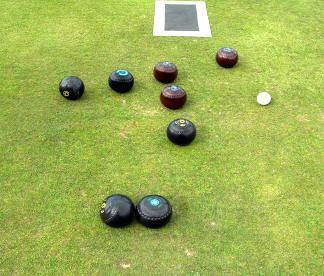Lawn bowls is usually played on a large, rectangular, precisely leveled and manicured grass or synthetic surface known as a bowling green which is divided into parallel playing strips called rinks.
Bowling greens come in all shapes and sizes, fast, slow, big crown, small crown etc and variations from green to green are common.
An indoor variation on carpet is also played.
In the simplest competition, singles, one of the two opponents flips a coin to see who wins the “mat” and begins a segment of the competition (in bowling parlance, an “end”), by placing the mat and rolling a small white ball (the jack) to the other end of the green to serve as a target. Once it has come to rest, the jack is aligned to the center of the rink and the players take turns to roll their bowls from the mat towards the jack and thereby build up the “head”.

A bowl may curve outside the rink boundary on its path, but must come to rest within the rink boundary to remain in play. Bowls falling into the ditch are dead and removed from play, except in the event when one has touched the jack on its way. “Touchers” are marked with chalk and remain alive in play even though they are in the ditch. Similarly if the jack is knocked into the ditch it is still alive unless it is out of bounds to the side, resulting in a “dead” end which is then usually replayed. However, international rules require the jack to be “respotted” to the center of the rink and the end is continued. After each competitor has delivered all of their bowls (four each in singles and pairs, three each in triples, and two bowls each in fours), the distance of the closest bowls to the jack is determined (the jack may have been displaced) and points, called “shots”, are awarded for each bowl which a competitor has closer than the opponent’s nearest to the jack. For instance, if a competitor has bowled two bowls closer to the jack than their competitor’s nearest, they are awarded two shots. The exercise is then repeated for the next end, a game of bowls typically being of twenty one ends.
Equipment
Bowls are designed to travel a curved path because of a weight bias which was originally produced by inserting weights in one side of the bowl. This is no longer permitted by the rules and bias is now produced entirely by the shape of the bowl. A bowler determines the bias direction of the bowl in his hand by a dimple or symbol on one side. Regulations determine the minimum bias allowed, and the range of diameters (11.6 to 13.1 cm), but within these rules bowlers can and do choose bowls to suit their own preference. They were originally made from lignum vitae, a dense wood giving rise to the term “woods” for bowls, but are now more typically made of a hard plastic composite material.
Bowls were once only available coloured black or brown but they are now available in a variety of colours including a range of fluorescent hues. They have unique symbol markings engraved on them for identification. Since many bowls look the same, coloured, adhesive stickers or labels are also used to mark the bowls of each team in bowls matches. Some local associations agree specific colours for stickers for each of the clubs in their area.
Provincial or national colors are often assigned in national and international competitions. These stickers are used by officials to distinguish teams. Bowls have symbols unique to the set of four for identification. The side of the bowl with a larger symbol within a circle indicates the side away from the bias. The side with a smaller symbol within a smaller circle is the bias side toward which the bowl will turn. It is not uncommon for players to deliver a “wrong bias” shot from time to time and see their carefully aimed bowl crossing neighbouring rinks rather than heading towards their jack.
